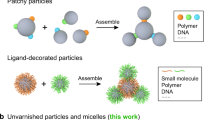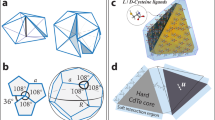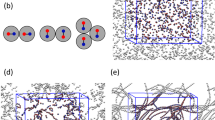Abstract
Details of the forces between nanoparticles determine the ways in which the nanoparticles can self-assemble into larger structures. The use of directed interactions has led to new concepts in self-assembly such as asymmetric dendrons1,2, Janus particles3, patchy colloids4,5,6 and colloidal molecules7. Recent models that include attractive regions or ‘patches’ on the surface of the nanoparticles predict a wealth of intricate modes of assembly8,9,10,11,12. Interactions between such particles are also important in a range of phenomena including protein aggregation13,14 and crystallization15, re-entrant phase transitions16,17,18, assembly of nanoemulsions19 and the organization of nanoparticles into nanowires20. Here, we report the synthesis of 6-nm nanoparticles with dynamic hydrophobic patches and show that they can form reversible self-assembled structures in aqueous solution that become topologically more connected upon dilution. The organization is based on guest–host supramolecular chemistry with the nanoparticles composed of a hydrophobic dendrimer host molecule and water-soluble hydrophilic guest molecules. The work demonstrates that subtle changes in hierarchal composition and/or concentration can dramatically change mesoscopic ordering.
This is a preview of subscription content, access via your institution
Access options
Subscribe to this journal
Receive 12 print issues and online access
$259.00 per year
only $21.58 per issue
Buy this article
- Purchase on Springer Link
- Instant access to full article PDF
Prices may be subject to local taxes which are calculated during checkout





Similar content being viewed by others
References
Maraval, V. et al. Rapid synthesis of phosphorus-containing dendrimers with controlled molecular architectures: first example of surface-block, layer-block and segment-block dendrimers issued from the same dendron. J. Am. Chem. Soc. 122, 2499–2511 (2000).
Grayson, S. M. & Fréchet, J.-M. J. Synthesis and surface functionalization of aliphatic polyether dendrons. J. Am. Chem. Soc. 122, 10335–10344 (2000).
Roh, K.-H., Martin, D. C. & Lahann, J. Biphasic Janus particles with nanoscale anisotropy. Nature Mater. 4, 759–763 (2005).
Zheng, R., Liu, G. & Yan, X. Polymer nano- and microspheres with bumpy and chain-segregated surfaces. J. Am. Chem. Soc. 127, 15358–15359 (2005).
Breen, T. L., Tien, J., Oliver, S. R. J., Hadzic, T. & Whitesides, G. M. Design and self-assembly of open, regular, 3D mesostructures. Science 284, 948–951 (1999).
Cho, Y.-S. et al. Self-organization of bidisperse colloids in water droplets. J. Am. Chem. Soc. 127, 15968–15975 (2005).
Manoharan, V. N., Elsesser, M. T. & Pine, D. J. Dense packing and symmetry in small clusters of microspheres. Science 301, 483–487 (2003).
Zhang, Z. & Glotzer, S. C. Self-assembly of patchy particles. Nano Lett. 4, 1407–1413 (2004).
Doye, J. P. K. et al. Controlling crystallization and its absence: proteins, colloids and patchy models. Phys. Chem. Chem. Phys. 9, 2197–2205 (2007).
Kern, N. & Frenkel, D. Fluid–fluid coexistence in colloidal systems with short-ranged strongly directional attraction. J. Chem. Phys. 118, 9882–9889 (2003).
Bianchi, E., Largo, J., Tartaglia, P., Zaccarelli, E. & Sciortino, F. Phase diagram of patchy colloids: towards empty liquids. Phys. Rev. Lett. 97, 168301 (2006).
Huisman, B. A. H., Bolhuis, P. G. & Fasolino, A. Phase transition to bundles of flexible supramolecular polymers. Phys. Rev. Lett. 100, 188301 (2008).
Lomakin, A., Asherie, N. & Benedek, G. B. Aeolotopic interactions of globular proteins. Proc. Natl Acad. Sci. USA 96, 9465–9468 (1999).
van der Linden, E. & Venema, P. Self-assembly and aggregation of proteins. Curr. Opin. Colloid Interface Sci. 12, 158–165 (2007).
De Michele, C., Gabrielli, S., Tartaglia, P. & Sciortino, F. Dynamics in the presence of attractive patchy interactions. J. Phys. Chem. B 110, 8064–8079 (2006).
Eckert, T. & Bartsch, E. Re-entrant glass transition in a colloid–polymer mixture with depletion. Phys. Rev. Lett. 89, 125701 (2002).
Nguyen, T. T. & Shklovskii, B. I. Complexation of DNA with positive spheres: phase diagram of charge inversion and reentrant condensation. J. Chem. Phys. 115, 7298–7308 (2001).
Zhang, F. et al. Reentrant condensation of proteins in solution induced by multivalent counterions. Phys. Rev. Lett. 101, 148101 (2008).
Bibette, J., Mason, T. G., Gang, H., Weitz, D. A. & Poulin, P. Structure of adhesive emulsions. Langmuir 9, 3352–3356 (1993).
Tang, Z., Kotov, N. A. & Giersig, M. Spontaneous organization of single CdTe nanoparticles into luminescent nanowire. Science 297, 237–240 (2002).
Chang, T. et al. Structural elucidation of dendritic host–guest complexes by X-ray crystallography and molecular dynamics simulations. Chem. Eur. J. 13, 7883–7889 (2007).
Baars, M. W. P. L., Karlsson, A. J., Sorokin, V., de Waal, B. F. W. & Meijer, E. W. Supramolecular modification of the periphery of dendrimers resulting in rigidity and functionality. Angew Chem. Int. Ed. 39, 4262–4265 (2000).
Broeren, M. A. C. et al. Multivalency in the gas phase: the study of dendritic aggregates by mass spectrometry. Angew Chem. Int. Ed. 43, 3557–3562 (2004).
Broeren, M. A. C. et al. Multicomponent host–guest chemistry of carboxylic acid and phosphonic acid based guests with dendritic hosts: an NMR study. J. Am. Chem. Soc. 127, 10334–10343 (2005).
Banerjee, D., Broeren, M. A. C., van Genderen, M. H. P., Meijer, E. W. & Rinaldi, P. L. An NMR study of the supramolecular chemistry of modified poly(propyleneimine) dendrimers. Macromolecules 37, 8313–8318 (2004).
Broeren, M. A. C. et al. Noncovalent synthesis of supramolecular dendritic architectures in water. J. Polym. Sci. A 43, 6431–6437 (2005).
Hermans, T. M. et al. Stepwise noncovalent synthesis leading to dendrimer-based assemblies in water. J. Am. Chem. Soc. 129, 15631–15638 (2007).
Schenning, A. P. H. J. et al. Amphiphilic dendrimers as building blocks in supramolecular assemblies. J. Am. Chem. Soc. 120, 8199–8208 (1998).
Cui, S.-M. & Chen, Z. Y. Monte Carlo simulations of randomly branched polymers with annealed and quenched branching structures. Phys. Rev. E 53, 6238–6243 (1996).
Gutin, A. M., Grosberg, A. Yu. & Shakhnovich, E. I. Polymers with annealed and quenched branchings belong to different universality classes. Macromolecules 26, 1293–1295 (1993).
Witten, T. A. & Pincus, P. A. Structured Fluids (Oxford Univ. Press, 2004).
Babu, S., Rottereau, M., Nicolai, T., Gimel, J. C. & Durand, D. Flocculation and percolation in reversible cluster–cluster aggregation. Eur. Phys. J. E 19, 203–211 (2006).
Wielgus-Kutrowska, B., Narczyk, M., Buszko, A., Bzowska, A. & Clark, P. L. Folding and unfolding of a non-fluorescent mutant of green fluorescent protein. J. Phys. Condens. Matter 19, 285223 (2007).
Baskakov, I. V., Legname, G., Prusiner, S. B. & Cohen, F. E. Folding of prion protein to its native α-helical conformation is under kinetic control. J. Biol. Chem. 276, 19687–19690 (2001).
Pelta, M. D., Morris, G. A., Stchedroff, M. J. & Hammond, S. J. A one-shot sequence for high-resolution diffusion-ordered spectroscopy. Magn. Reson. Chem. 40, S147–S152 (2002).
Acknowledgements
The authors thank BSIK project 03033 and the Netherlands Organization for Scientific Research for financial support.
Author information
Authors and Affiliations
Contributions
T.M.H. wrote the paper and performed NMR and viscosity measurements and performed the analysis of the fractal dimension of the WBP reconstruction from cryo-electron tomography. M.A.C.B. contributed materials. N.G. and G.F. performed and analysed light-scattering experiments. N.A.J.M.S. performed cryo-electron microscopy and tomography and analysis. P.V.D.S. helped with the theoretical understanding of the coupled equilibria. All authors discussed the results and commented on the manuscript.
Corresponding author
Supplementary information
Supplementary information
Supplementary information (PDF 1477 kb)
Supplementary movie
Supplementary movie (WMV 7576 kb)
Rights and permissions
About this article
Cite this article
Hermans, T., Broeren, M., Gomopoulos, N. et al. Self-assembly of soft nanoparticles with tunable patchiness. Nature Nanotech 4, 721–726 (2009). https://doi.org/10.1038/nnano.2009.232
Received:
Accepted:
Published:
Issue Date:
DOI: https://doi.org/10.1038/nnano.2009.232
This article is cited by
-
Controlling the length of porphyrin supramolecular polymers via coupled equilibria and dilution-induced supramolecular polymerization
Nature Communications (2022)
-
Aggregation shapes of amphiphilic ring polymers: from spherical to toroidal micelles
Colloid and Polymer Science (2020)
-
Precise hierarchical self-assembly of multicompartment micelles
Nature Communications (2012)
-
Clay goes patchy
Nature Materials (2011)
-
Miktoarms hyperbranched polymer brushes: One-step fast synthesis by parallel click chemistry and hierarchical self-assembly
Science China Chemistry (2010)



